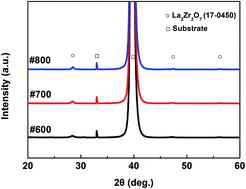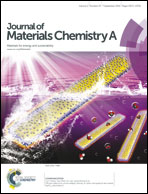Sol–gel derived Li–La–Zr–O thin films as solid electrolytes for lithium-ion batteries
Abstract
Li–La–Zr–O thin films were successfully fabricated using a sol–gel spin coating method, and the effects of altering the annealing temperature and the number of layers of the films on electrolyte conductivity were studied. Using X-ray diffraction, scanning electron microscopy and X-ray photoelectron spectroscopy, the characteristics of these films were investigated as a function of annealing temperature and the numbers of layers of the film. With these methods, an amorphous structure and a smooth surface on the films were revealed. The thin film's ionic conductivity was investigated by impedance analysis. The results show that the ionic conductivity of the films decreases with an increase of the annealing temperature, from 1.67 × 10−6 S cm−1 for 600 °C annealing to 8.53 × 10−7 S cm−1 for 800 °C annealing. The influence of film thickness on conductivity was investigated and the conductivity followed an inverse u-shaped curve with increasing film thickness. We propose that Li–La–Zr–O thin films may be promising solid electrolytes for solid-state lithium-ion batteries.


 Please wait while we load your content...
Please wait while we load your content...